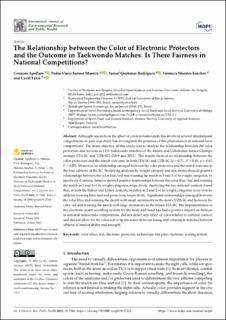| dc.contributor.author | Apollaro, Gennaro | |
| dc.contributor.author | Moreira, Pedro V. Sarmet | |
| dc.contributor.author | Quiñones-Rodríguez, Yarisel | |
| dc.contributor.author | Morales-Sánchez, Verónica | |
| dc.contributor.author | Falco, Coral | |
| dc.date.accessioned | 2023-01-12T14:19:05Z | |
| dc.date.available | 2023-01-12T14:19:05Z | |
| dc.date.created | 2022-06-23T14:58:33Z | |
| dc.date.issued | 2022 | |
| dc.identifier.citation | International Journal of Environmental Research and Public Health (IJERPH). 2022, 19 (12), . | en_US |
| dc.identifier.issn | 1661-7827 | |
| dc.identifier.uri | https://hdl.handle.net/11250/3043138 | |
| dc.description.abstract | Although research on the effect of color in taekwondo has involved several international competitions, no previous study has investigated the presence of this phenomenon in national-level competitions. The main objective of this study was to analyze the relationship between the color protectors and success in 1155 taekwondo matches of the Italian and Uzbekistan Senior Championships (ITA-SC and UZB-SC) (2019 and 2021). The results showed no relationship between the color protectors and the match outcome, in both ITA-SC and UZB-SC (p = 0.71, V = 0.01; p = 0.61, V = 0.02). Moreover, no relationship emerged between the color protectors and the match outcome in the four editions of the SC. Stratifying analyses by weight category and sex, males showed positive relationships between the color blue/red and winning the match in 3 and 1 of 16 weight categories, respectively. Contrary, females showed positive relationships between the color blue/red and winning the match in 1 and 3 of 16 weight categories, respectively. Analyzing the two national contexts found that, in both the Italian and Uzbek contexts, matches in 2 and 2 of 16 weight categories were won by athletes wearing blue and red protectors, respectively. Significant relationships emerged between the color blue and winning the match with small asymmetry in the men’s UZB-SC and between the color red and winning the match with large asymmetry in the female ITA-SC. The implementation of the electronic point recording system for the body and head has had a positive impact on fairness in national taekwondo competitions, did not detect any effect of color related to cultural context, and did not allow for the color red to tip the scales between losing and winning in matches between athletes of similar ability and strength. | en_US |
| dc.language.iso | eng | en_US |
| dc.publisher | MDPI | en_US |
| dc.rights | Navngivelse 4.0 Internasjonal | * |
| dc.rights.uri | http://creativecommons.org/licenses/by/4.0/deed.no | * |
| dc.title | The Relationship between the Color of Electronic Protectors and the Outcome in Taekwondo Matches: Is There Fairness in National Competitions? | en_US |
| dc.type | Peer reviewed | en_US |
| dc.type | Journal article | en_US |
| dc.description.version | publishedVersion | en_US |
| dc.rights.holder | © 2022 by the authors | en_US |
| dc.source.pagenumber | 14 | en_US |
| dc.source.volume | 19 | en_US |
| dc.source.journal | International Journal of Environmental Research and Public Health (IJERPH) | en_US |
| dc.source.issue | 12 | en_US |
| dc.identifier.doi | 10.3390/ijerph19127243 | |
| dc.identifier.cristin | 2034599 | |
| cristin.ispublished | true | |
| cristin.fulltext | original | |
| cristin.qualitycode | 1 | |

